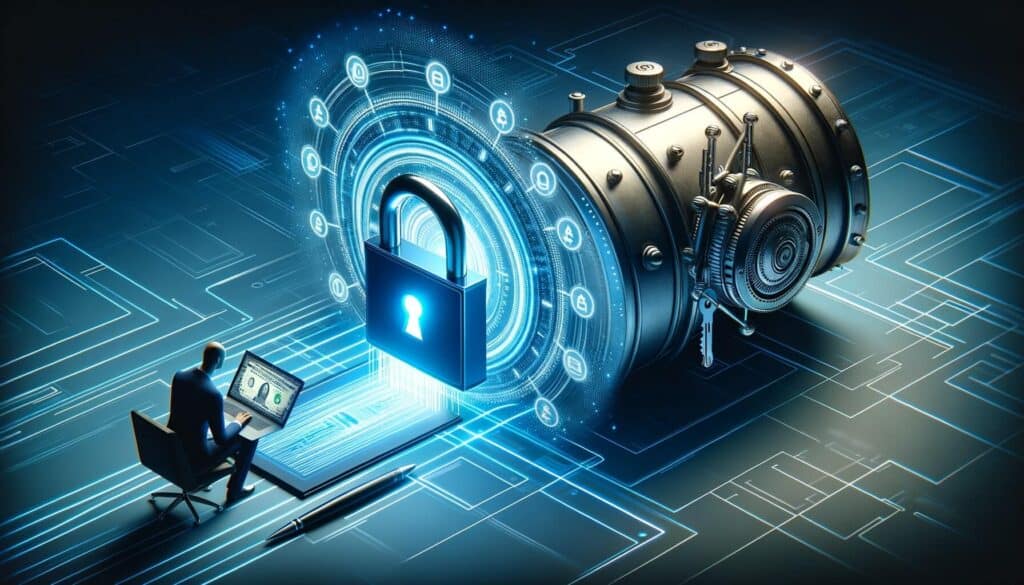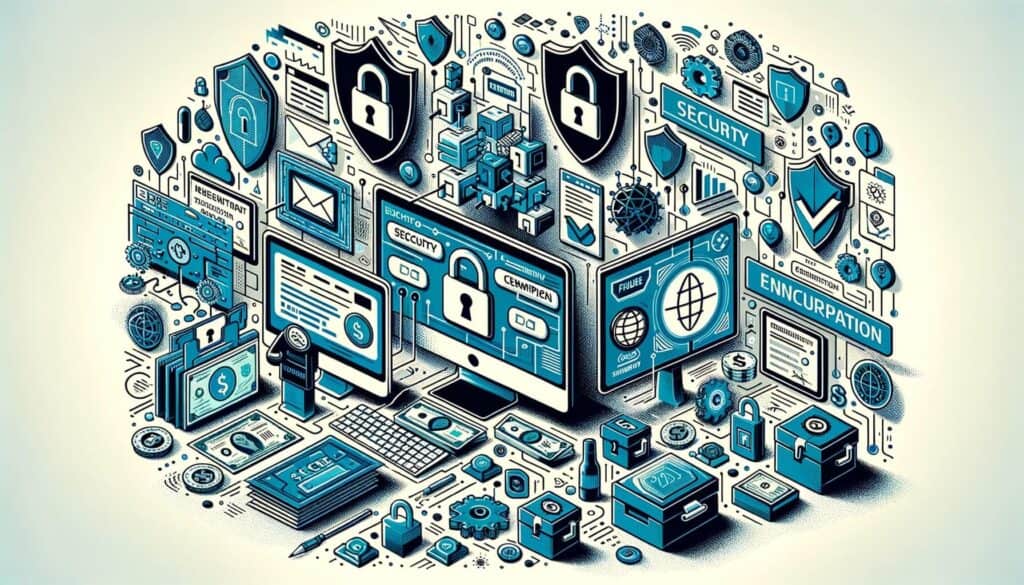
By Harriet Forster January 15, 2025
In today’s digital age, electronic payments have become increasingly popular and convenient. One such method is the electronic check, which allows individuals and businesses to send and receive payments electronically, eliminating the need for paper checks.
In this article, we will explore the ins and outs of electronic checks, including their benefits, how to set them up, choosing the right service provider, ensuring security, costs and fees, troubleshooting tips, integrating them into business operations, and a comparative analysis with traditional checks.
Understanding the Benefits of Sending Electronic Checks

Electronic checks offer numerous benefits over traditional paper checks. Firstly, they are much faster and more efficient. With eChecks, payments can be processed and cleared within a matter of hours, compared to the days or even weeks it takes for paper checks to be processed. This speed is particularly advantageous for businesses that need to receive payments quickly to maintain cash flow.
Secondly, eChecks are more secure. Paper checks can easily be lost or stolen, putting sensitive financial information at risk. Electronic checks, on the other hand, are encrypted and transmitted securely, reducing the chances of fraud or unauthorized access to personal information.
Furthermore, eChecks are more environmentally friendly. By eliminating the need for paper checks, we can reduce the amount of paper waste and contribute to a greener planet. This is especially important as businesses and individuals strive to adopt sustainable practices.
Step-by-Step Guide: How to Set Up Electronic Check Payments
Setting up electronic check payments is a relatively straightforward process. Here is a step-by-step guide to help you get started:
1. Choose an eCheck service provider: The first step is to select a reputable eCheck service provider. Look for providers that offer secure and reliable payment processing services, as well as competitive pricing.
2. Gather necessary information: Before you can start sending electronic checks, you will need to gather some essential information. This includes your bank account details, such as the routing number and account number, as well as the recipient’s information.
3. Set up an account: Once you have chosen a service provider, you will need to set up an account with them. This typically involves providing your personal and business information, as well as linking your bank account.
4. Verify your account: After setting up your account, you may need to verify it by providing additional documentation, such as proof of identity or business registration. This step is crucial for security purposes and to comply with anti-money laundering regulations.
5. Add recipients: Once your account is verified, you can start adding recipients to whom you want to send electronic checks. This can be done by entering their bank account details, including the routing number and account number.
6. Initiate a payment: To send an eCheck, you will need to initiate a payment through your service provider’s platform. This typically involves entering the payment amount, selecting the recipient, and confirming the transaction.
7. Confirm and review: Before finalizing the payment, it is essential to review all the details to ensure accuracy. Double-check the recipient’s information, payment amount, and any additional notes or memos you want to include.
8. Submit the payment: Once you are satisfied with the details, submit the payment through your service provider’s platform. The funds will be debited from your account and transferred to the recipient’s account electronically.
9. Track and reconcile payments: After sending an electronic check, it is crucial to track and reconcile the payments to ensure they have been received and processed correctly. Most service providers offer reporting and reconciliation tools to simplify this process.
10. Maintain security: Finally, it is essential to maintain the security of your electronic check payments. This includes regularly updating your account passwords, monitoring your transactions for any suspicious activity, and promptly reporting any issues to your service provider.
Choosing the Right eCheck Service Provider

When it comes to choosing an electronic check service provider, there are several factors to consider. Here are some key considerations to help you make an informed decision:
1. Security: The security of your eCheck transactions should be a top priority. Look for service providers that offer robust encryption and data protection measures to ensure the confidentiality and integrity of your financial information.
2. Reliability: It is crucial to choose a service provider that offers reliable payment processing services. This includes minimal downtime, fast transaction processing times, and excellent customer support to address any issues or concerns promptly.
3. Integration capabilities: If you are a business looking to integrate electronic check payments into your existing systems, consider service providers that offer seamless integration capabilities. This will allow you to streamline your payment processes and improve efficiency.
4. Pricing: Compare the pricing structures of different service providers to ensure you are getting the best value for your money. Look for transparent pricing models that clearly outline any fees or charges associated with electronic check transactions.
5. Reputation and reviews: Research the reputation and customer reviews of potential service providers. Look for providers with a solid track record and positive feedback from their clients. This will give you confidence in their ability to deliver reliable and secure payment processing services.
Ensuring Security and Fraud Prevention in Electronic Check Transactions

Security and fraud prevention are paramount when it comes to electronic check transactions. Here are some measures you can take to ensure the security of your payments:
1. Choose a reputable service provider: As mentioned earlier, selecting a reputable service provider is crucial for security. Look for providers that have robust security measures in place, such as encryption, multi-factor authentication, and fraud detection systems.
2. Keep your information secure: Safeguard your account information and login credentials. Use strong, unique passwords and enable two-factor authentication whenever possible. Avoid sharing sensitive information over unsecured networks or with unauthorized individuals.
3. Regularly monitor your transactions: Keep a close eye on your eCheck transactions and promptly report any suspicious activity to your service provider. Regularly review your account statements and reconcile your payments to ensure they are accurate and authorized.
4. Educate yourself and your employees: Stay informed about the latest security threats and best practices for electronic check transactions. Educate yourself and your employees about common scams, phishing attempts, and other fraudulent activities to minimize the risk of falling victim to them.
5. Implement additional security measures: Consider implementing additional security measures, such as firewalls, antivirus software, and intrusion detection systems, to protect your systems and data from unauthorized access.
Exploring the Costs and Fees Associated with Electronic Checks
While electronic checks offer numerous benefits, it is essential to understand the costs and fees associated with using this payment method. Here are some common costs and fees to consider:
1. Transaction fees: Most eCheck service providers charge a transaction fee for each payment processed. This fee can vary depending on the provider and the volume of transactions. Some providers offer tiered pricing structures, where the transaction fee decreases as the transaction volume increases.
2. Monthly fees: Some service providers may charge a monthly fee for using their electronic check services. This fee typically covers access to their platform, customer support, and additional features or tools.
3. Setup fees: In some cases, service providers may charge a one-time setup fee to activate your account and configure your payment processing settings. This fee can vary depending on the complexity of your requirements.
4. Return fees: If an electronic check payment is returned due to insufficient funds or other reasons, service providers may charge a return fee. This fee is typically deducted from your account balance and can vary depending on the provider.
5. Integration fees: If you are integrating eCheck payments into your existing systems, there may be additional fees associated with the integration process. These fees can vary depending on the complexity of the integration and the level of support required from the service provider.
6. Miscellaneous fees: Some service providers may charge additional fees for services such as account maintenance, reporting and reconciliation tools, or customer support beyond standard business hours. It is essential to review the fee schedule of your chosen provider to understand all potential costs.
Common Challenges and Troubleshooting Tips for Electronic Check Payments
While electronic check payments offer numerous benefits, they can also come with their fair share of challenges. Here are some common challenges and troubleshooting tips to help you navigate these issues:
1. Payment delays: Occasionally, eCheck payments may experience delays due to various factors, such as technical issues or processing times. If you encounter a payment delay, reach out to your service provider’s customer support for assistance. They can investigate the issue and provide updates on the status of your payment.
2. Insufficient funds: If an electronic check payment is returned due to insufficient funds in your account, it is crucial to address the issue promptly. Contact your service provider to understand the reason for the return and take the necessary steps to resolve the situation, such as depositing sufficient funds into your account.
3. Incorrect recipient information: Accidentally entering incorrect recipient information can result in failed or misdirected payments. Before initiating a payment, double-check the recipient’s bank account details, including the routing number and account number, to ensure accuracy. If you realize an error after submitting the payment, contact your service provider immediately to rectify the situation.
4. Fraudulent activity: While electronic check transactions are generally secure, there is always a risk of fraudulent activity. If you suspect any unauthorized or fraudulent transactions, report them to your service provider immediately. They can investigate the issue and take appropriate action to protect your account and funds.
5. Technical issues: Occasionally, technical issues may arise during the eCheck payment process. If you encounter any technical difficulties, such as system errors or connectivity problems, contact your service provider’s technical support for assistance. They can guide you through troubleshooting steps or escalate the issue to their technical team for resolution.
Integrating Electronic Check Payments into Your Business Operations
Integrating electronic check payments into your business operations can streamline your payment processes and improve efficiency. Here are some tips for successful integration:
1. Assess your needs: Before integrating eCheck payments, assess your business needs and requirements. Consider factors such as transaction volume, payment frequency, and the level of integration required with your existing systems.
2. Choose a compatible payment gateway: If you have an online presence, choose a payment gateway that supports electronic check payments. Ensure that the gateway integrates seamlessly with your website or e-commerce platform to provide a smooth payment experience for your customers.
3. Train your staff: If you have employees involved in the payment processing or reconciliation process, provide them with proper training on how to handle electronic check payments. This includes understanding the payment flow, using the service provider’s platform, and troubleshooting common issues.
4. Update your accounting systems: Ensure that your accounting systems are compatible with eCheck payments. This may involve updating your software or implementing additional modules to support electronic check transactions.
5. Communicate with your customers: If you are introducing electronic check payments as a new payment option, communicate this to your customers. Update your website, marketing materials, and customer communications to inform them about the availability and benefits of eCheck payments.
Electronic Check vs. Traditional Check: A Comparative Analysis
While electronic checks offer numerous advantages over traditional paper checks, it is essential to understand the differences between the two payment methods. Here is a comparative analysis of electronic checks and traditional checks:
1. Speed and efficiency: Electronic checks are significantly faster and more efficient than traditional checks. eChecks can be processed and cleared within hours, while traditional checks can take days or even weeks to be processed.
2. Security: Electronic checks offer enhanced security compared to traditional checks. eChecks are encrypted and transmitted securely, reducing the risk of fraud or unauthorized access to personal information. Traditional checks, on the other hand, can easily be lost or stolen, putting sensitive financial information at risk.
3. Cost: Electronic checks can be more cost-effective than traditional checks. Electronic check transactions typically have lower processing fees compared to the costs associated with printing, mailing, and processing traditional checks.
4. Environmental impact: Electronic checks are more environmentally friendly than traditional checks. By eliminating the need for paper checks, eChecks help reduce paper waste and contribute to a greener planet.
5. Acceptance: While electronic checks are becoming increasingly popular, not all businesses or individuals accept them. Traditional checks, on the other hand, are widely accepted and familiar to most people. It is essential to consider the acceptance of electronic checks in your business or personal transactions.
FAQs
Q1. Are electronic checks the same as ACH payments?
While electronic checks and ACH payments are similar in nature, there are some differences. ACH payments are a broader category that includes various electronic payment methods, including eChecks. Electronic checks specifically refer to payments made by electronically transmitting the check information, including the bank account and routing numbers.
Q2. Can I send electronic checks internationally?
The availability of international eCheck payments depends on the service provider and the countries involved. Some service providers offer international payment options, while others may have restrictions or limitations. It is advisable to check with your service provider regarding their international payment capabilities.
Q3. How long does it take for an electronic check to clear?
The time it takes for an electronic check to clear can vary depending on various factors, including the service provider, the recipient’s bank, and any additional processing requirements. In general, eChecks can clear within one to three business days, but it is advisable to check with your service provider for specific timelines.
Q4. Can I cancel or stop an eCheck payment?
Once an eCheck payment has been authorized and initiated, it may not be possible to cancel or stop the payment. However, if you realize there is an error or need to dispute a payment, you should contact your service provider immediately to explore possible options.
Q5. Are eChecks more secure than credit card payments?
Both eChecks and credit card payments offer security measures to protect your financial information. However, the level of security can vary depending on the specific service provider and the measures they have in place. It is advisable to choose a reputable service provider that prioritizes security and employs robust encryption and authentication methods.
Conclusion
Electronic checks offer numerous benefits over traditional paper checks, including speed, security, efficiency, and environmental friendliness. By following a step-by-step guide, choosing the right service provider, ensuring security, understanding costs and fees, troubleshooting common issues, and integrating eCheck payments into your business operations, you can leverage the advantages of this payment method.
While electronic checks may not completely replace traditional checks, they provide a convenient and secure alternative in today’s digital world.